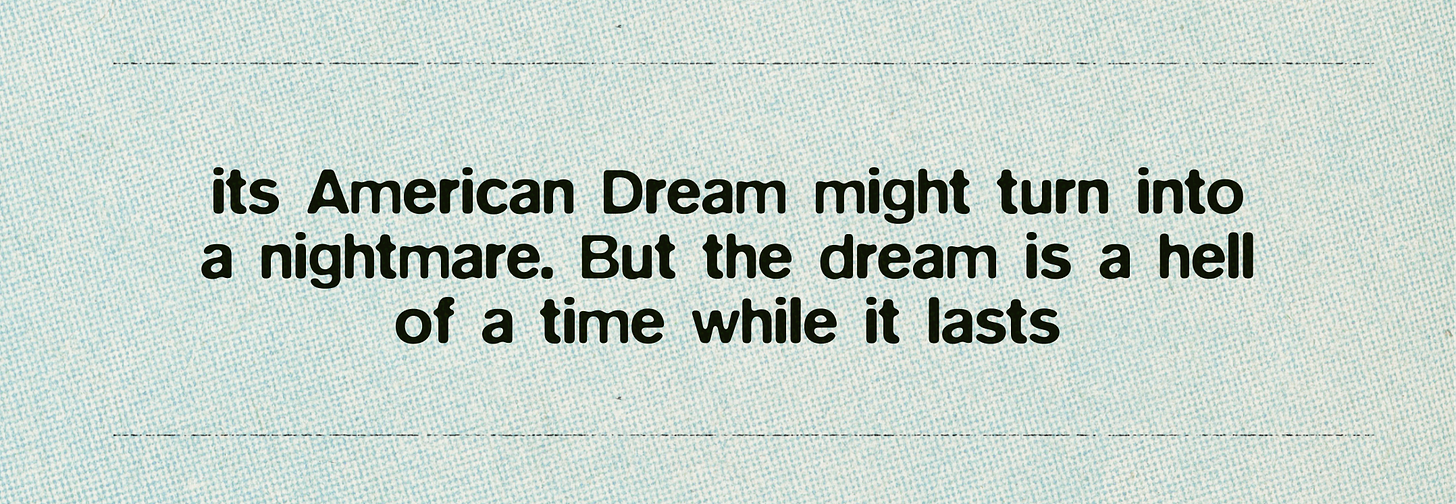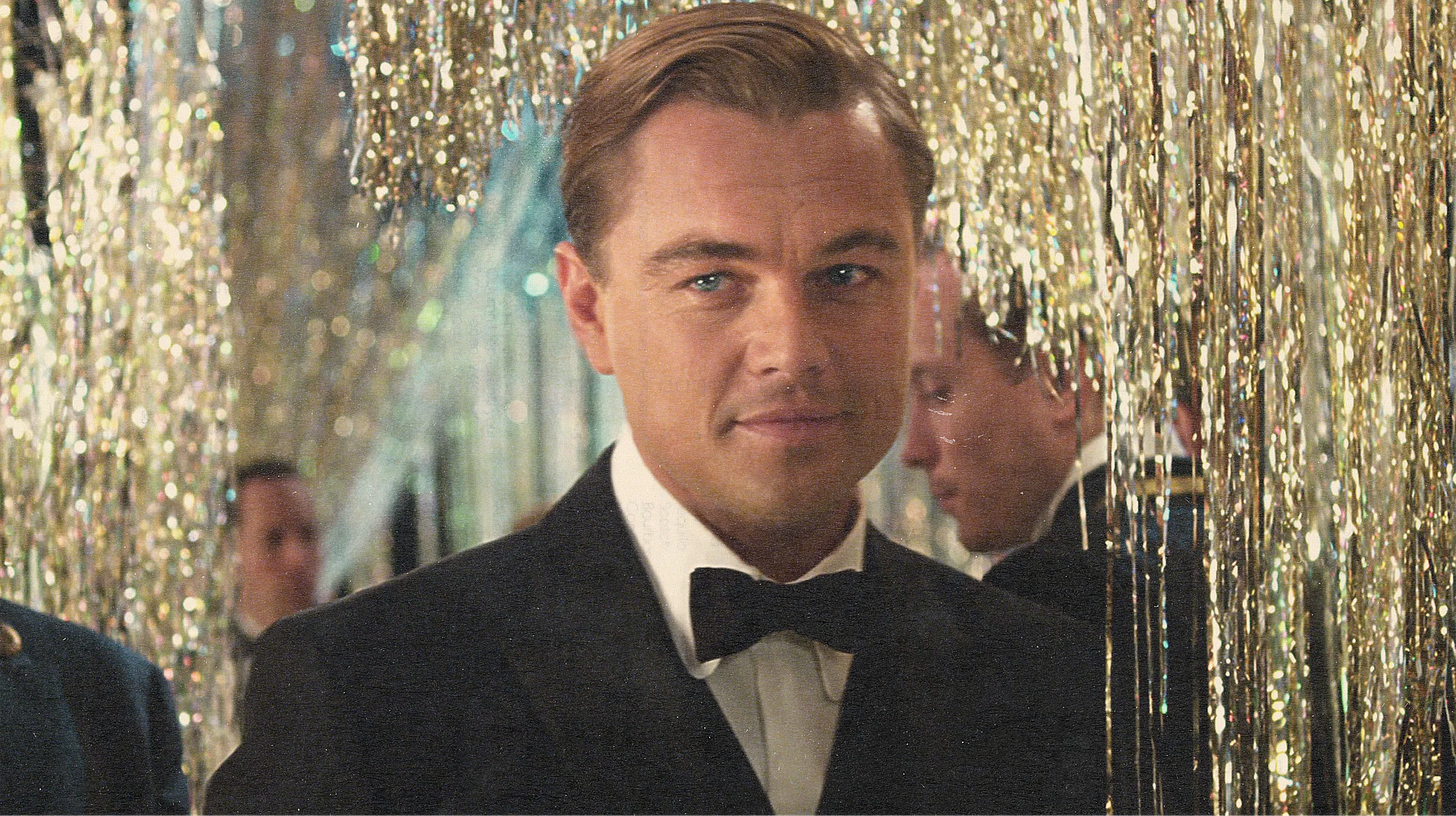Based On, If Any: The Great Gatsby (2013)
West Egg from a Bird’s-Eye View
Brittany Menjivar is watching adaptations. Previously, she watched Nosferatu, The Polar Express, Secretary, and Rave Macbeth.
Some people “raw-dog” flights; I “Gatsby” them. This is to say, almost every time I board a plane, I stream Baz Luhrmann’s 2013 adaptation of F. Scott Fitzgerald’s The Great Gatsby. Check the in-flight movie options next time you travel: it is always there.
To be fair, I don’t always watch it fully—sometimes I merely play it in the background as I listen to music, read, or write. Yet I remain ever beholden to its vivid imagery. Just as Gatsby believed in the promise of the green light, I believe in the promise of the greenlight—i.e., the fact that Warner Bros. and Columbia decided to greenlight this film brings me hope for the future of literary cinema. (Should I workshop that one? Ok, fine; not all of Gatsby’s jokes landed, either.)
The Great Gatsby is not my favorite film of all time. However, I would wholeheartedly support a campaign to rename it The Great American Plane Movie. It owes its greatness (no pun intended) to Fitzgerald as much as it does Luhrmann: Luhrmann is able to bring James Gatz’s mythos to life with such grandeur because Fitzgerald wrote a character who could sell himself so persuasively to everyone who encountered him, including the reader. Here are the reasons I find myself escaping to West Egg every time I take to the skies.
1. The soundtrack
Sometime in the early 2010s, my friends and I gathered in a suburban basement, clustered around an iPhone. The song blasing through from the speakers could only be described as the sound of the future. A high-pitched, computerized voice whined over booming bass and glitchy, abrasive beats. The track: Skrillex’s “Scary Monsters and Nice Sprites.” The genre: dubstep.
When the melody disappeared, replaced by the sound of screams and clashing noises, it was as if the floor had been pulled out from beneath my black Converse All-Stars. I felt the same way when I first heard “Who Gon Stop Me,” a Jay-Z & Kanye West collab that interpolates Flux Pavillion’s dubstep single “I can’t Stop,” playing during the party scene with Catherine in Luhrmann’s film. Occasionally, the scene cuts away from the debauchery to display a trumpeter on a nearby balcony: the whine of his horn blends seamlessly with the music, adding a bit of Jazz Age flair.
Luhrmann’s unconventional choice to use hip-hop and electronic music in place of a period-accurate 1920s score received its fair share of criticism at the time of the film’s release. Seeing the film as a teenager, the sense of excitement and abandon it was intended to convey was immediately palpable to me. Essentially turning the movie into one big music video, it makes the action flash past at the speed of sound—just as it’ll make your flight whizz by.
2. The maximalism
I proudly identify as a Baz Luhrmann apologist. How could I not? As a kid, I latched onto the PG-rated romps of Robert Rodriguez, with The Adventures of Sharkboy and Lavagirl in 3D taking the cake. I was primed to adore maximalism from an early age—so The Great Gatsby’s extravagant montages, bird’s-eye-view shots, voiceover narration, and floating typewriter text are right up my alley. The film’s penchant for spectacle incidentally makes it ideal for an in-flight flick. Find yourself dozing off, losing track of the plot? Not to worry: not a single frame of this film is boring. Whichever sequences you do see will make an impression on you, no matter how brief.
After the film first hit theaters, there was much ado about the Prohibition-themed parties that followed in its wake. Homecomings, birthday shindigs, even wedding receptions deployed vaguely Art Deco decor; I recall the phrase “Ain’t no party like a Gatsby party” making the rounds. (The early 2010s were a different time.) As more and more revelers got caught up in their desire to time travel, a snooty backlash emerged: It’s kind of ironic since the novel was actually criticizing Gatsby’s excess, don’t you think?
While this may be somewhat true, I view the Gatsby craze of 2013 as a testament to the power of Fitzgerald’s mythology. Not only did the legend of Gatsby transcend centuries—it crossed over from fantasy to reality. All of us ’90s babies became just as obsessed with this fictional man as people born in the 1890s were. And isn’t there something special, something revelatory, even, about the fable’s inherently participatory nature, which Luhrmann’s film so cleverly put its finger on?
The Great Gatsby ends in tragedy; its American Dream turns into a nightmare. But the dream is a hell of a time while it lasts—and Fitzgerald wanted us to experience it this way. The Great Gatsby was far from a humorless screed—indeed, it’s hard to find a page that isn’t teeming with wisecracks or grin-inducing details. Luhrmann’s film translates its infectious ethos to the screen.
3. The casting
The Great Gatsby stars Leonardo di Caprio, who is the undisputed King of Plane Movies. Shutter Island, Romeo + Juliet (another Bazsterpiece), Inception, Titanic… these films are all extravagant and multisensory enough to be considered prime plane fare. Yet The Great Gatsby is the platonic ideal of a Leo-helmed plane paragon, because the actor bears a certain similarity to Gatsby himself: they are both the subject of rampant rumors.
Gatsby is suspected to be a German spy or a bootlegger. “I heard he killed a man once,” a minor character pipes up at one point. As for di Caprio, just Google “Leonardo di Caprio” + “headphones” + “MGMT.” I have heard whispers about him performing this “ritual” in a greenhouse, although I have no way of verifying this information since I am off the market.
True or false? Does it even matter? The point is that, in both cases, the myth is bigger than the man. As Lana del Rey, chanteuse behind Great Gatsby soundtrack hit “Young and Beautiful,” once sang, “Life imitates art.”
The Great Gatsby is now in the public domain, so there’s no telling what adaptations are around the bend. We have already seen Nick and Gatsby as lovers, Nick as Latino, Nick with scoliosis, and Jordan Baker as a witch. Like all the best tales, the story is bound to mutate over time… but when the seatbelt sign turns on and the flight attendant tells me to put my phone on airplane mode, I know which iteration I’ll turn to.







Really makes me so happy reading your great piece - I worked on this film for over a year of my life (Costume Design Assistant) and I am just so proud of this crazy film we made. Maximalism forever!